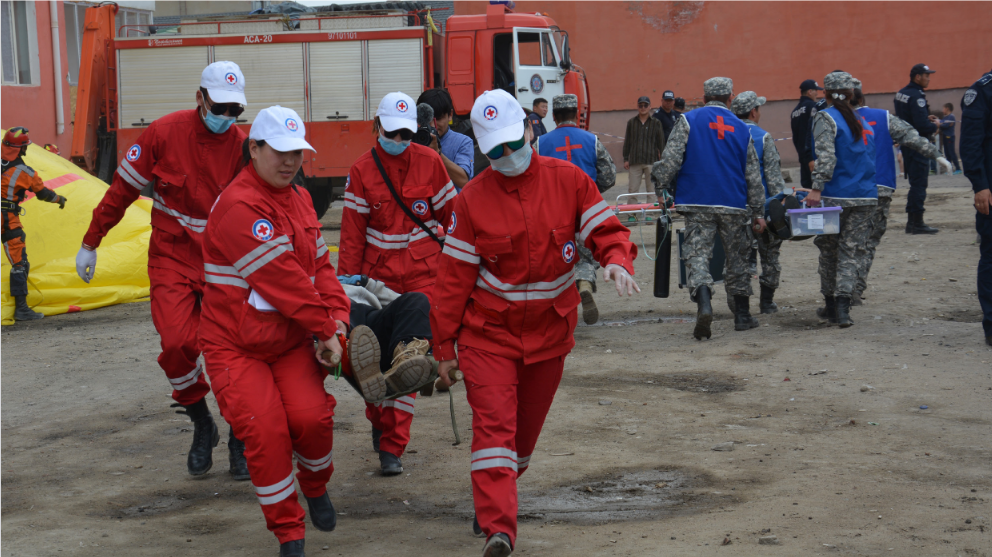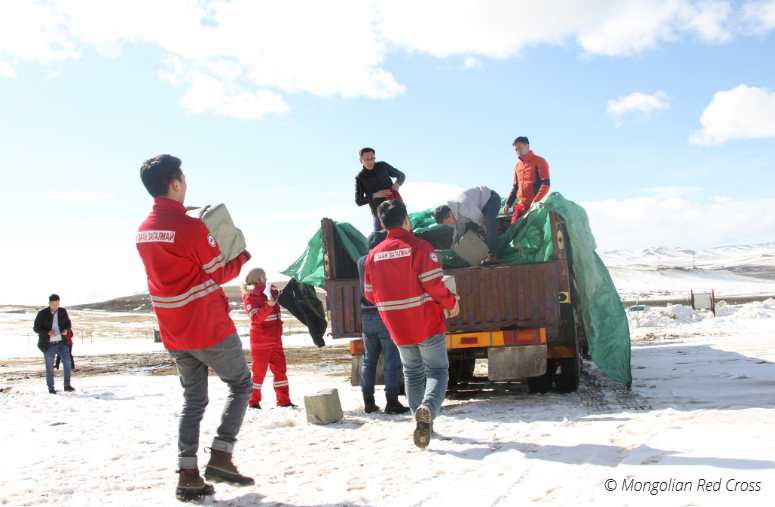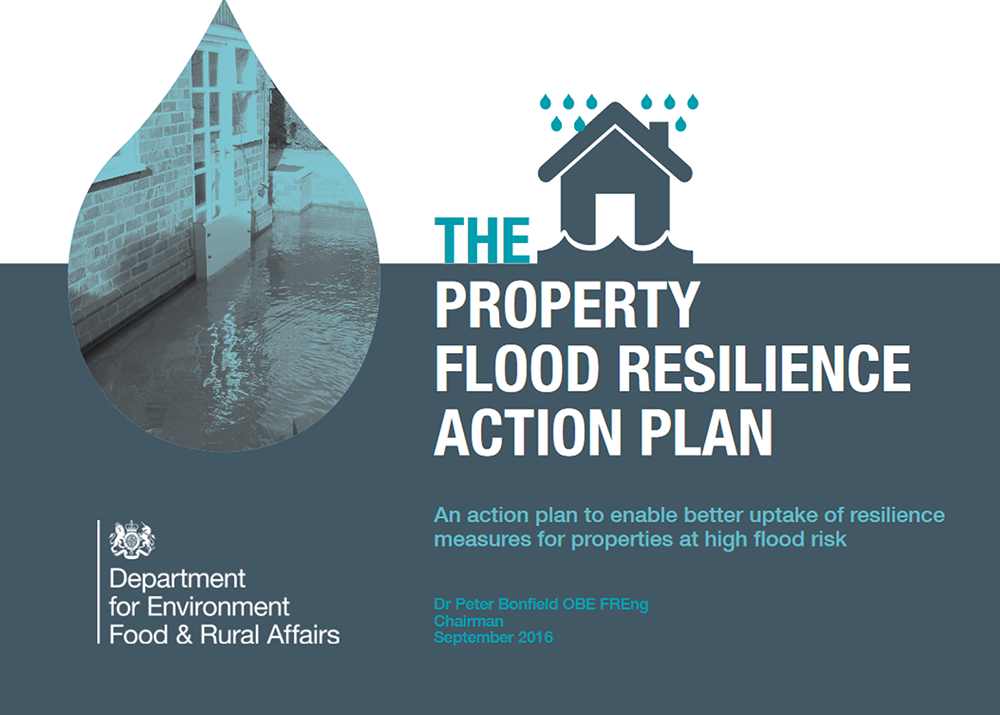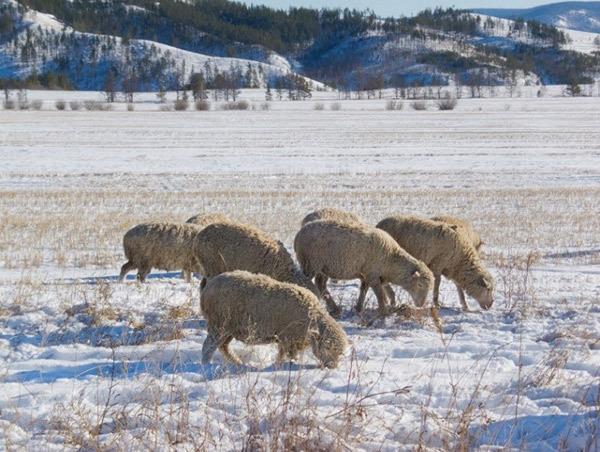
©Mongolian Red Cross Society
Issue
Mongolia is prone to natural disasters and extreme weather events, including storms, droughts, floods, earthquakes, and severe dzud winters. Densely populated urban areas of the capital are in medium to high flood-risk zones, where evacuations are needed to prevent loss of life. In rural regions, herding households’ livelihoods depend on mild summers and winters for their livestock to have adequate access to pasture for grazing; otherwise, the animals may die.
Natural disasters’ frequency and intensity are increasing due to climate change. Mongolia will likely experience increased temperatures and precipitation, depleted water resources, and decreased cultivable farmland. Rapid and unplanned urban development may also worsen flooding and other natural disasters’ effects on urban inhabitants.
Solution
The Mongolian Red Cross Society (MRCS) works with the Mongolian Government’s Permanent Emergency Commission and the National Emergency Management Agency to build prevention, preparedness, and recovery capacity during humanitarian crises. The National Society assessed the MRCS’s preparedness for disaster response from 2016, and the MRCS responded by improving its preparedness measures, raising its capacity.
Overview
In Mongolia, the International Federation of Red Cross and Red Crescent Societies’ (IFRC) Mongolian Red Cross Society (MRCS) provides humanitarian assistance to vulnerable populations to save lives and livelihoods during natural disasters and humanitarian crises. From 2016 to 2019, the IFRC National Society assessed the MRCS’s disaster preparedness, and the MRCS made empirical improvements to its preparedness measures.
Details
Natural disasters in Mongolia threaten the lives and livelihoods of vulnerable populations. The increasing threat of climate change, along with rapid urban development, places more Mongolians at risk during severe weather events.
The International Federation of Red Cross and Red Crescent Societies’ (IFRC) Mongolian Red Cross Society (MRCS) works with the Mongolian government and the National Emergency Management Agency (NEMA) to provide humanitarian assistance when natural disasters strike. The IFRC National Society (NS) operates the MRCS programs through four main divisions:
- disaster management
- social inclusion and development
- public health promotion
- Red Cross Youth
The MRCS has been working to build disaster response capacity based on NS assessments. The MRCS collaborates with the IFRC, Red Cross, and the Red Crescent Climate Center to establish early action protocols and prepare financial mechanisms. In 2017–2020, these preparations proved necessary as the MRCS responded to fires, floods, and harsh dzud winters (when large numbers of steppe animals die after hot and dry summers and icy winters), taking actions such as distributing cash assistance and livestock nutrition kits to prevent loss of livelihoods.
Factors enabling the success of disaster preparedness
To strengthen disaster preparedness capacity, the MRCS took several steps using the Preparedness for Effective Response (PER) approach. First, the MRCS strengthened its functional capacities in disaster management. It achieved this through technical training of people, volunteer development, and support of the Red Cross Youth Movement. The MRCS also revised the existing preparedness plan to prevent loss of institutional knowledge from loss of long-term staff.
Additionally, the MRCS fostered ownership of and commitment to the preparedness process among MRCS staff. MRCS staff attended a weeklong PER reorientation away from their duty stations to measure their preparedness. The training allowed the staff to invest quality time and dedicate themselves to response preparedness.
MRCS understood the importance of collaboration between sectors and areas when preparing for effective disaster management. Various groups from public health, legal services, management, and others joined the disaster management team to assist with developing disaster preparedness. The groups’ collaboration enabled clear identification of responsibilities for different departments when disasters occur.

©Mongolian Red Cross Society
Response and preparedness capacity in Mongolia
From 2016 to 2019, the NS found the MRCS’s overall response and preparedness capacity rating rose from 2.10 to 3.21. Several factors account for this rise. The area of analysis and planning of response preparedness showed a marked increase, likely attributable to the Early Action Protocols used to address the dzud winter.
In 2016, no pre-disaster agreements were in place, but by 2019, such agreements were established and rated as performing well, also contributing to the rating increase. Agreements with the National Emergency Management Agency, Ministry of Health, Social Welfare, Trade Development Bank, and with other private-sector organizations were developed in this period. The MRCS’s Emergency Operations Center was also not created in 2016. This new facility serves as a command center during natural disasters and other emergencies, creating communication channels and improving communication, further increasing the rating.
A disaster response capacity enhancement simulation exercise was conducted in 2016 to identify areas of improvement for communications, safety, and security during an emergency. The simulation led to the creation of an action plan, specifying that 60% of 400 volunteers are equipped with personal protective equipment for use during an emergency. This exercise strengthened the disaster preparedness capacity.
In 2017, the MRCS assisted in amending the Mongolian Disaster Protection Law, revitalizing the legal base for disaster preparedness. In the revised law, the MRCS is listed as a sole national humanitarian organization that can call for international assistance. The information contained in the law was disseminated to staff and volunteers for their awareness, which also helped boost the rating.
Multi-sectoral and multi-funded plan development
Through the PER approach from the NS, the MRCS created a plan to further develop its disaster response capacity. The plan encourages collaboration among multiple stakeholder groups and draws from multiple funding resources.
The multi-sectoral and multi-funded approach was used for several reasons. As MRCS’s natural disaster response capacity increases, it’s also looking to build capacity in other areas, such as health emergencies. The multi-sectoral approach enabled increased collaboration with the Australian Red Cross on influenza preparedness and may help identify partnership opportunities with other preparedness programs. Representatives from other services, such as resource mobilization, and administration and planning, were also present in developing the plan, allowing for collaboration toward effective and timely response measures.
The response plan developed over four years demonstrates the effectiveness of the PER approach in building capacity for disaster preparedness, serving as a model for similar programs in vulnerable areas around the world.




